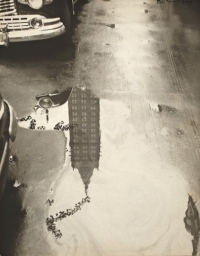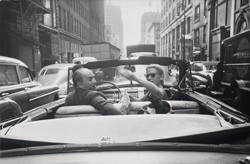New York 1947–1954
In February 1947 Frank sailed from Antwerp to New York. In April, upon seeing 40 Fotos, the Russian-born photographer, designer, and art director Alexey Brodovitch hired Frank as an assistant photographer at Harper's Bazaar. Frank also began publishing both commercial and independent work in a variety of magazines and journals, including Camera, Life, and Das Wochenende. By October Frank had resigned from Harper's Bazaar, although he would continue to contribute as a freelance photographer until 1951.
During his early years in New York, Frank immersed himself in the burgeoning photography scene there and responded to the work of Louis Faurer, Sid Grossman, and André Kertész as well as the German-born British photographer Bill Brandt and the Frenchman Henri Cartier-Bresson. He became acquainted with photographers Elliott Erwitt, Walker Evans, and Edward Steichen as well as publisher Robert Delpire.
Encouraged and inspired by Brodovitch, Frank picked up a 35mm Leica camera, which offered more freedom and spontaneity than his square-format Rolleiflex. He also allowed himself to respond intuitively to the fast pace, constant motion, and overwhelming stimuli of New York. The resulting pictures from this period—including one with a trapezoidal format and another that focuses on a reflection rather than the object itself—display a new level of experimentation as well as more developed attention to light, tone, gesture, and expression.
Selected photographs, New York 1947–1954


